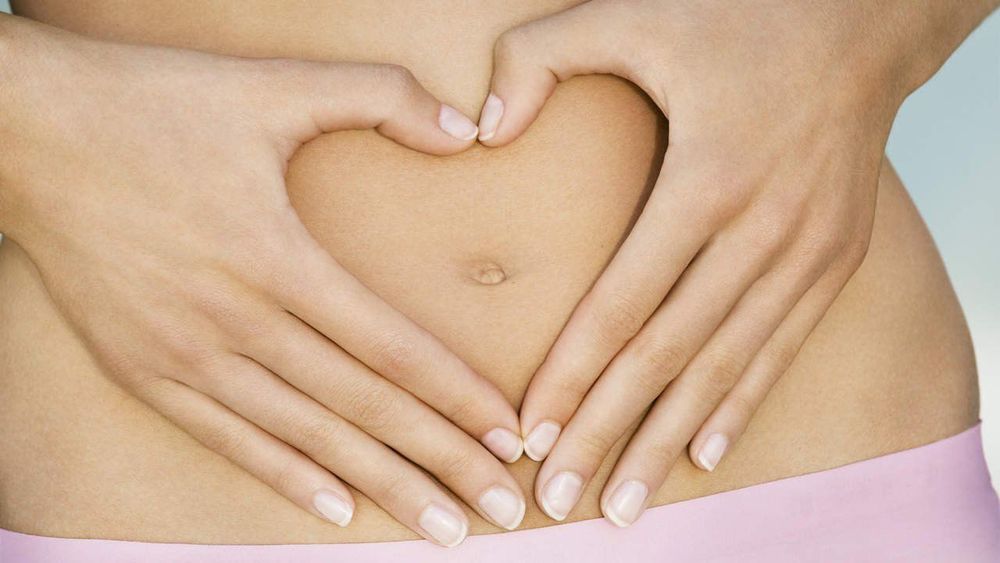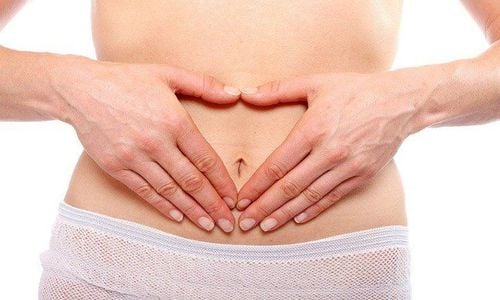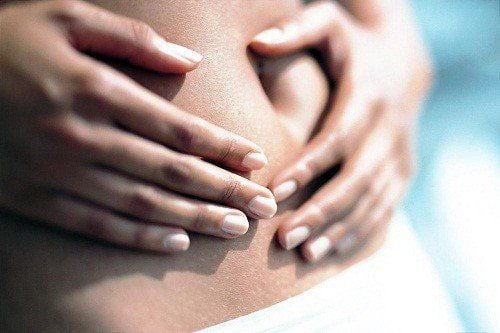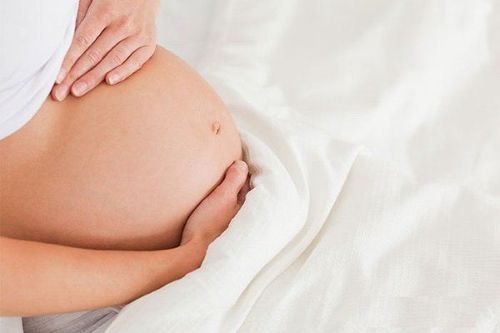This is an automatically translated article.
The article was professionally consulted by Doctor Nguyen Thi Hong On - Department of Obstetrics and Gynecology, Vinmec Phu Quoc International General Hospital. The doctor has 10 years of experience in Obstetrics and Gynecology and has worked in all positions in the clinic area, delivery room, emergency room for obstetrics and gynecology, procedure room and treatment area on request.After giving birth, your uterus will take about 6-8 weeks to return to its original size and shape. However, the time it takes for the uterus to shrink depends on the location of each person and how to take care of the mother after giving birth.
1. What is uterine contraction?
Uterine contractions are changes in the lining, muscles, body, cervix, .. after childbirth. During pregnancy, the uterus and muscles are stretched to support the fetus in the womb.After the placenta is delivered, the uterus will contract tightly into a mass, the bottom of the uterus is located just below the mother's navel. After birth, the weight of the uterus is about 1000g, over time, the body of the uterus changes, causing the weight of the uterus to gradually decrease to about 100g until the last period of the postpartum period.
The time for the uterus to shrink will take about 6-8 weeks depending on the body of each person. For those who have a cesarean section, it takes longer for the uterus to return to normal. The normal state of the uterus is 50-60g.
In addition, uterine contractions also occur during the monthly menstrual cycle and are referred to as “menstrual cramps”.

Thời gian để tử cung co hồi lại sẽ mất khoảng 6-8 tuần tùy thuộc vào cơ địa của từng người
2. Uterine contractions
One of the signs for pregnant women to recognize the process of labor is uterine contractions. There are 3 uterine contractions that you may experience, including:2.1 Braxton – Hicks contractions (Physical contractions) Physiological contractions usually occur around the 4th month of pregnancy, however it occurs. sudden, irregular and infrequent. Braxton-Hicks contractions are an effective way to get your uterus ready for labor.
Physiological contractions usually have the following characteristics:
No pain Has a feeling of concentration in the abdomen May make you feel uncomfortable Lower abdomen feels tight Physiological contractions do not affect your uterus If your body is changed, contractions will appear when your body is tired, dehydrated or walking too much. If the pregnant mother rests and relaxes properly, this contraction will disappear.
2.2 Premature uterine contractions If uterine contractions occur frequently before 37 weeks of pregnancy, it is most likely a sign of preterm labor. The contractions will appear regularly in time cycles, for example each contraction occurs for about 10-12 minutes for more than 1 hour, signaling you may be about to give birth prematurely. When contractions occur, your abdomen will be firmer to the touch along with a tightening sensation in the uterus. Some signs you may notice are:
Dull pain Pelvic pressure Pressure in the abdomen Spasms or cramps You should go to the hospital immediately if any of the symptoms listed above appear , especially accompanied by vaginal bleeding, rupture of membranes (with water coming out of the vagina). Pregnant women should also pay attention to monitor the interval between uterine contractions or the frequency of contractions and accompanying symptoms to notify the doctor and provide timely intervention.
2.3 Uterine contractions in labor

Những cơn gò này giúp cho cổ tử cung của thai phụ mở rộng, sẵn sàng cho việc sinh con sắp tới
Early stage of labor: During this stage, the contractions are still at a gentle level, the feeling of tightness in the uterus or lower abdomen will pull. 30-90 seconds long. Uterine contractions will appear gradually increasing in intensity and distance. Closer to labor, contractions appear closer together (may appear after 5 minutes).
True labor: The contractions appear more often and cause more pain for the pregnant woman. At this time, the cervix will dilate from 4-10cm, preparing for the baby to come out. You will feel the contractions surrounding the whole body, from the back to the front of the abdomen.
In addition, you may also experience leg cramps. During labor, uterine contractions will last from 60-90 seconds and the interval between each contraction is from 30 seconds to 2 minutes. The contractions may appear overlapping in order to push the baby out. Some of the symptoms that you may experience during labor contractions include:
Chills or hot flashes Vomiting Stomach bloating Ợ Gas Farting.
3. How long after giving birth does the uterus shrink back?
About 1-2 days after giving birth, your uterus will shrink to the size of an 18 week pregnancy. Over the next few days, the size of the uterus will continue to decrease. You may experience abdominal pain for a few weeks as your uterus is shrinking back after giving birth. If nothing unusual happens, about 6 weeks after giving birth, the uterus can return to its original size and shape.However, how fast or slow the uterus contracts depends on many different factors. Those who give birth vaginally, the recovery speed of the uterus will be faster than those born through caesarean section, because during the cesarean section, there will be scars. In addition, mothers who give birth for the first time, the uterus will also recover faster than those who give birth to second children.
During the contraction of the uterus, the remaining fluid will be brought out of the body through strong contractions. The degree of contraction more or less depends on the number of births as well as the location of each person. In future births, the uterus will have to increase the rate of contractions stronger and more powerful to be able to push the fluid out.
4. How does slow uterine contraction affect postpartum health?

Co hồi tử cung chậm có thể ảnh hưởng đến lần mang thai tiếp theo
Uterine infection Uterine prolapse Affecting subsequent pregnancies If signs such as The uterus shrinks slowly, feels hard on the abdomen, fever, pain, foul-smelling discharge, there is a high risk of you having a postpartum infection. In particular, the life of the mother can be in danger if bleeding occurs due to the uterus not retracting in the first day after giving birth.
5. Factors affecting uterine contractions
Several factors can influence the process of uterine contractions of mothers after giving birth, namely:5.1 Number of births Later births will take longer than the first time to get into the uterus. shrink back.
5.2 How to give birth by cesarean section usually takes longer for the uterus to contract than a vaginal birth.
5.3 How to take care of pregnant women after giving birth If taking care of pregnant women after giving birth incorrectly, the contraction of the uterus will take place more slowly than usual, and even conditions such as inflammation and infection may occur. at birth.
5.4 Infections Pregnant women who have an infection after giving birth will have a longer time for uterine contractions.
5.5 Abstain from urinating Improper urination also significantly affects the process of uterine contraction, leading to other dangerous complications such as postpartum hemorrhage, cystitis.
5.6 Formulation Breastfeeding People who breastfeed their babies will have slower contractions than those who breastfeed.
6. Ways to help shrink the uterus after giving birth quickly

Những cơn gò này giúp cho cổ tử cung của thai phụ mở rộng, sẵn sàng cho việc sinh con sắp tới
You should lie on your stomach with pillows under your hips. This helps the pelvic organs return to normal. Gently massage the uterus by using one hand to enter the lower abdomen, continuously massaging in circles to stimulate the uterus, helping the uterus recover quickly. Gentle exercise to relieve stress and fatigue. Because when the body is in the best state, the uterus can recover quickly and discharge better. You should urinate when there is a need, do not hold urine because it can cause bladder swelling, urinary retention, and hinder the process of uterine contraction. You should breastfeed your baby to stimulate the nipples, helping the uterus to contract faster. In addition, you can also massage the nipple regularly. Keep the vaginal area clean to avoid infection. You should clean with warm water or boiled water to cool. In addition to the above methods, mothers after giving birth should also establish a nutritious and scientific diet, combined with foods containing substances that help shrink the uterus quickly, such as gizzards. Grilled chicken, minced pork tenderloin soup, fried chicken with fresh turmeric,...
Vinmec International General Hospital offers a comprehensive maternity care program for pregnant women right from the first months of pregnancy. with full prenatal check-ups, periodical 3D and 4D ultrasounds and routine tests to ensure that the mother is healthy and the fetus develops comprehensively. Pregnant women will be consulted and checked for health under the close supervision of experienced and specialized obstetricians, helping mothers gain more knowledge to protect their health during pregnancy as well as minimize complications affecting mother and child.
Please dial HOTLINE for more information or register for an appointment HERE. Download MyVinmec app to make appointments faster and to manage your bookings easily.













